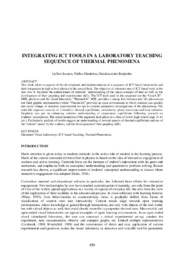Integrating ICT tools in a laboratory teaching sequence of thermal phenomena

View/Open
Date
2005Author
Psillos, Dimitris
Lefkos, Ioannis
Hatzikraniotis, Euripides
Metadata
Show full item recordAbstract
This work refers to aspects of the development and implementation of a sequence of ICT based laboratories and their integration in high school physics in the area of heat. The objective of extensive use of ICT based tools in the labs was to facilitate the enhancement of students’ understanding of the main concepts of heat as well as the development of their graphing and experimental skills. The ICT tools used in this sequence are the “Coach II” - MBL platform and the visual laboratory “Thermolab”. MBL provides a strong link between real-life phenomena and their graphic representation while “Thermolab” provides an open environment in which students can quickly and easily change or structure experimental set ups to conduct parametric investigations of the phenomena. The main lab sequence consists of 4 modules: thermal equilibrium, calorimetry, phase transitions and heat radiation. Emphasis was put on enhancing students understanding of temperature equilibrium following research on students’ conceptions. The implementation of the sequence took place in a class of lower high school (age 13-14 yrs.). Preliminary analysis of results suggest an understanding of several aspects of thermal equilibrium and use of the “caloric” model by the students, and the development of their graphing skills.